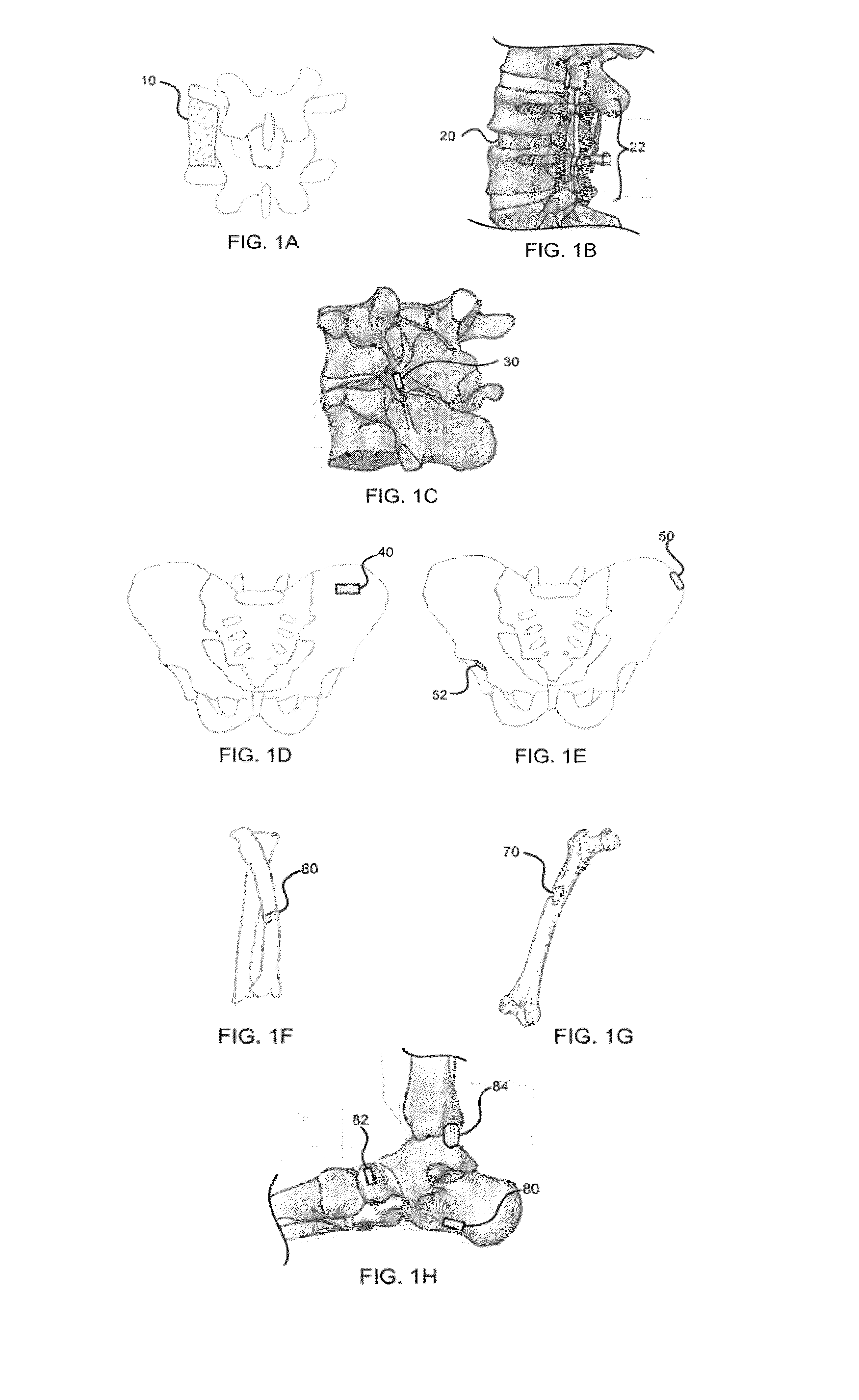Moldable bone graft compositions
a bone graft and composition technology, applied in the field of compositions, can solve the problems of increasing the risk of infection, increasing the pain and discomfort of patients, increasing the risk of disease transmission and graft rejection, etc., and achieves the effects of superior synthetic bone graft material, facilitating surgeon handling, and maintaining the placement of granules
- Summary
- Abstract
- Description
- Claims
- Application Information
AI Technical Summary
Benefits of technology
Problems solved by technology
Method used
Image
Examples
example 1
Moldable Bone Graft Composition
[0168]A synthetic bone graft composition, comprising: (1) resorbable alkylene oxide polymer (AOP) carrier, (2) biphasic granulate (HA / β-TCP, 60:40), and (3) 45S5 bioactive glass, in a single homogenous and moldable implant, was prepared.
[0169]The moldable bone graft composition comprised the components as previously set forth in Table 1.
[0170]The moldable bone graft composition was found to provide optimal intra-operative handling, sustained bioactivity, and a resorption profile that allows gradual and consistent defect remodeling consistent with the host remodeling response.
[0171]The utilized particle size range of the bioactive glass component (212-425 μm) has demonstrated advantages over the more common broader ranges featured in commercial bioactive glass products.
[0172]It was discovered that a narrow particle size distribution will yield a more controlled rate of ion dissolution and surface reactivity, producing a more consistent rate of bone bond...
example 2
Demonstration of Bioactivity of Bioactive Glass Component
[0179]The bioactive glass component of the moldable bone graft composition utilized in Example 1 undergoes a unique surface modification within the physiological environment that allows for direct bonding with surrounding bone. Following implantation, an exchange of biologically active ions produces a bioactive hydroxy carbonate apatite (HCA) layer to which bone can readily bond to. These surface reactions are followed by the proliferation and differentiation of bone related cells on the apatite matrix as part of the normal healing process. For example, the moldable bone graft composition taught herein demonstrated apatite layer formation in a simulated body fluid (SBF) on the bioactive glass surface in as early as 1 day (FIG. 3).
[0180]We have determined that particle size distribution of bioactive glass is a critical factor to bone bonding performance. The particle size range of the bioactive glass (212-425 μm) utilized in th...
example 3
Demonstration of Biphasic Remodeling
[0181]Hydroxyapatite (HA) is similar in composition to human bone. However, the material is largely insoluble, with bone bonding limited to the surface. Despite compositional modifications such as “silicate substitution” as with Actifuse ABX (Apatech / Baxter), the potential for limited resorption and remodeling remains, which may leave the defect site susceptible to focused mechanical stress. See, e.g., Vaccaro A R. The Role of the Osteoconductive Scaffold in Synthetic Bone Graft. Orthopedics 2002, 25(5):571-78; Szpalski M, Gunzburg R. Applications of Phosphate-Based Cancellous Bone Void fillers in Trauma Surgery. Orthopedics 2002, 25(5):601-09.
[0182]Beta tricalcium phosphate (β-TCP) is similar in composition to amorphous bone precursors and readily undergoes remodeling, stimulated by the material's calcium phosphate rich surface layers. See, e.g., Szpalski M, Gurizburg R. Applications of Phosphate-Based Cancellous Bone Void fillers in Trauma Surge...
PUM
| Property | Measurement | Unit |
|---|---|---|
| melting temperature | aaaaa | aaaaa |
| particle size | aaaaa | aaaaa |
| particle size | aaaaa | aaaaa |
Abstract
Description
Claims
Application Information
 Login to View More
Login to View More - R&D
- Intellectual Property
- Life Sciences
- Materials
- Tech Scout
- Unparalleled Data Quality
- Higher Quality Content
- 60% Fewer Hallucinations
Browse by: Latest US Patents, China's latest patents, Technical Efficacy Thesaurus, Application Domain, Technology Topic, Popular Technical Reports.
© 2025 PatSnap. All rights reserved.Legal|Privacy policy|Modern Slavery Act Transparency Statement|Sitemap|About US| Contact US: help@patsnap.com



